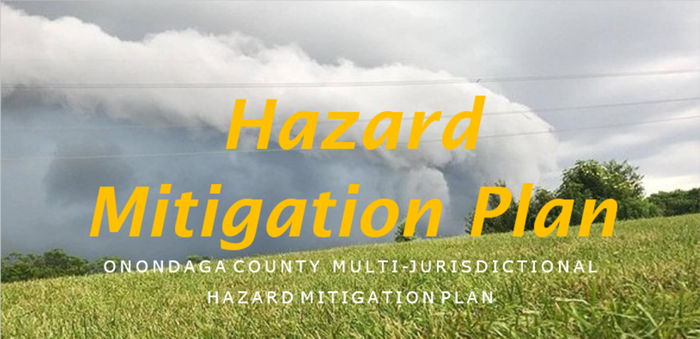
The Onondaga County Department of Planning is leading the 2025 five year update of the Onondaga County Multi-Jurisdictional Hazard Mitigation Plan for the County and its municipalities.
Click here to review and comment on the 2025 plan.
What is Hazard Mitigation?
Hazard mitigation describes any action taken to help reduce or eliminate long-term risks caused by natural hazards or disasters, such as storms, flooding, earthquakes, wildfires, landslides, or dam failure. The purpose of hazard mitigation is to protect people and structures, and minimize the costs of disaster response and recovery.
Hazard mitigation can take many forms, including capital projects, policies, and education. Proactive mitigation leads to more cost-effective projects. By contrast, reactive mitigation tends to lead to severe damage repair and often more costly fixes; it simply costs too much to address the effects of disasters only after they happen. A surprising amount of damage can be prevented if we can anticipate where and how disasters occur, and take steps to prevent those damages.
What is a Hazard Mitigation Plan?
A HMP is “the representation of the jurisdiction’s commitment to reduce risks from natural hazards, serving as a guide for decision makers as they commit resources to reducing the effects of natural hazards.” (44 CFR 201.6) HMPs establish and maintain eligibility for grant funds. The planning process is as important as the plan itself because it creates a framework for governments to reduce the negative impacts from future disasters on lives, property, and the economy. Hazard mitigation planning can significantly reduce the physical, financial, and emotional losses caused by disasters.
Onondaga County established a comprehensive, multi-jurisdictional Hazard Mitigation Plan for the County and its participating municipalities in 2013 through a grant from the Federal Emergency Management Agency (FEMA), with required five-year updates.
Why Have a Hazard Mitigation Plan?
The Disaster Mitigation Act of 2000 (DMA 2000) requires state and local governments to prepare local plans that will evaluate natural hazards and the strategies to mitigate such hazards. A Hazard Mitigation Plan can assist communities with the following:
- An increased understanding of the natural hazards the community faces.
- Development of more sustainable and disaster-resistant communities.
- Eligibility for federal funds for pre-disaster mitigation planning before disaster strikes.
- Potential financial savings to residents, including flood insurance premium reductions.
- Reduced long-term impacts and damages to human health and structures.
- Reduced repair costs.
What Does the Plan Do?
The Onondaga County Multi-Jurisdictional Hazard Mitigation Plan identifies natural hazards of concern in our region, assesses our specific vulnerabilities to those hazards, and seeks to identify projects and measures that may reduce damages from future hazards.
The plan includes a hazard risk and vulnerability assessment, mitigation strategies, jurisdictional annexes for participating jurisdictions in the County (e.g. city, towns, and villages), NYS Department of Homeland Security and Emergency Services (DHSES) requirements (e.g. assessing critical facilities, plan for climate change, and plan for displaced residents and evacuation/sheltering) and a plan maintenance strategy.
Climate Risk and Resilience Portal
To better assist local communities to mitigate these natural hazards, the Onondaga County Department of Planning, through the assistance of the Center of Excellence for Risk-Based Community Resilience Planning at Colorado State University, AT&T, and Integrated Solutions Consulting, leveraged insights from the Climate Risk and Resilience Portal (ClimRR, https://climrr.anl.gov/). ClimRR enables the community to look at simulated future climate conditions at mid- and end-of-century for a range of climate perils, and provides future climate data projections to help communities plan for and adapt to our changing weather. ClimRR can help local leaders address future conditions that impact identified hazards of concern, such as flooding and extreme heat
By combining the ClimRR climate data with other data layers, analysts evaluated the number of buildings in Onondaga County projected to experience pluvial flooding within the next 25-50 years. They also examined changes in trends in harmful algal blooms (HABs) due to changes in stormwater runoff and increased temperatures. Finally, utilizing inputs from Resilience Analysis and Planning Tool (RAPT), analysts pinpointed vulnerable populations that are susceptible to extreme heat. These analyses have been summarized in an ArcGIS StoryMap available here: https://arcg.is/1vHn541.
How Can I Participate?
The Hazard Mitigation Plan will be reviewed and updated regularly, and we welcome your continued input into this living document.
During plan development and update processes, a series of formal public meetings are held to solicit public comment and to present the draft plan to residents and local officials. We also conduct a web-based survey for residents and stakeholders to inform the planning process.
Have a concern about a local hazard, a project idea for the next Plan update, or want to know more about the process? Please feel free to contact your local municipality or the Onondaga County Department of Planning for more information.
More information on hazard mitigation is available through the Resources page.
|

